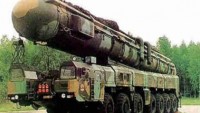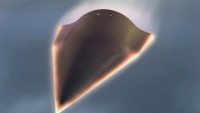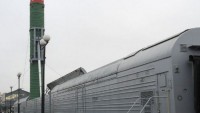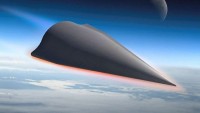First Flight Tests of Russia’s New Sarmat ICBM Scheduled for 1st Quarter Faces Delay
| Arthur Dominic Villasanta | | Jan 29, 2017 05:51 AM EST |
(Photo : Strategic Missile Troops ) Sarmat ICBM.
Russia plans the first flight test of its newest intercontinental ballistic missile (ICBM) -- the RS-28 Sarmat -- in February or March, that is, if technical glitches and money problems don't slow it down, which it probably will.
The silo-launched RS-28 Sarmat (NATO reporting name, Satan-2) was to have undergone pop-up tests in December 2016, which it apparently didn't. This has led to speculation flight testing might not take place during the first three months of 2017 as originally planned.
Like Us on Facebook
Russia did, however, reveal the first photos of Satan-2 in October following a successful first stage test in August.
In late 2016, Russia optimistically announced an initial deployment of Sarmat by 2018, two years ahead of schedule despite reports to the contrary from western sources. Western military analysts, however, said the more realistic deployment date is 2020 considering production of the missile is confirmed as behind schedule.
The Strategic Missile Troops or Strategic Rocket Forces of the Russian Federation is responsible for the Sarmat. It described this missile as a heavy ICBM being developed by the Makeyev Rocket Design Bureau.
Sarmat will have a liftoff mass of 100 metric tons, including a 10 metric ton payload consisting of nuclear warheads or decoys. It will replace the R-36 (NATO reporting name, SS-18 Satan) that Russia claims is today's most powerful ICBM in the world.
R-36 can carry up to 10 independently targetable re-entry vehicles, each having a yield of 750 kilotons
Sarmat has a far smaller liftoff mass but a greater range of flight compared to Satan. It can reach out to 17,000 kilometers compared to Satan's 11,000 km.
This longer range will allow Sarmat to attack targets along flight paths crossing the South Pole, from where they are least-expected and where no missile shields are being deployed by the United States.
Russia says each Sarmat can deploy 15 nuclear warheads, with yields ranging from 150 kilotons to 300 kilotons. It said these warheads will streak towards their targets at Mach 17 (20,000 km/h).
Sarmat can also deploy Russia's new hypersonic glide vehicle warhead, the Yu-71, which is still under development.
Some Russian analysts believe Sarmat will comprise 100% of Russia's silo-based ICBM force.
Russia has 521 operational ICBMs and submarine launched ballistic missiles (SLBMs) with 1,735 warheads while the United States has 741 ICBMs and SLBMs and 1,481 nuclear warheads.
TagsRussia, RS-28 Sarmat, SATAN 2, Strategic Missile Troops, R-36, SS-18 Satan, Yu-71
©2015 Chinatopix All rights reserved. Do not reproduce without permission
 China Claims Deploying DF-41 ICBMs, which aren’t Operational, to Heilongjiang to Threaten the US
China Claims Deploying DF-41 ICBMs, which aren’t Operational, to Heilongjiang to Threaten the US Russia’s Hypersonic Missile Development Program in Trouble
Russia’s Hypersonic Missile Development Program in Trouble Russian Navy to Receive World’s First Hypersonic Anti-Ship Missile
Russian Navy to Receive World’s First Hypersonic Anti-Ship Missile Russia to Deploy Military Trains Armed with Nuclear Missiles Targeting the United States
Russia to Deploy Military Trains Armed with Nuclear Missiles Targeting the United States Russia Claims Deployment of 'Sarmat' Heavy ICBM with 16 Nukes by 2018
Russia Claims Deployment of 'Sarmat' Heavy ICBM with 16 Nukes by 2018
EDITOR'S PICKS
-

Did the Trump administration just announce plans for a trade war with ‘hostile’ China and Russia?
-

US Senate passes Taiwan travel bill slammed by China
-

As Yan Sihong’s family grieves, here are other Chinese students who went missing abroad. Some have never been found
-

Beijing blasts Western critics who ‘smear China’ with the term sharp power
-

China Envoy Seeks to Defuse Tensions With U.S. as a Trade War Brews
-

Singapore's Deputy PM Provides Bitcoin Vote of Confidence Amid China's Blanket Bans
-

China warns investors over risks in overseas virtual currency trading
-

Chinese government most trustworthy: survey
-

Kashima Antlers On Course For Back-To-Back Titles
MOST POPULAR
LATEST NEWS
Zhou Yongkang: China's Former Security Chief Sentenced to Life in Prison

China's former Chief of the Ministry of Public Security, Zhou Yongkang, has been given a life sentence after he was found guilty of abusing his office, bribery and deliberately ... Full Article
TRENDING STORY

China Pork Prices Expected to Stabilize As The Supplies Recover

Elephone P9000 Smartphone is now on Sale on Amazon India

There's a Big Chance Cliffhangers Won't Still Be Resolved When Grey's Anatomy Season 13 Returns

Supreme Court Ruled on Samsung vs Apple Dispute for Patent Infringement

Microsoft Surface Pro 5 Rumors and Release Date: What is the Latest?









